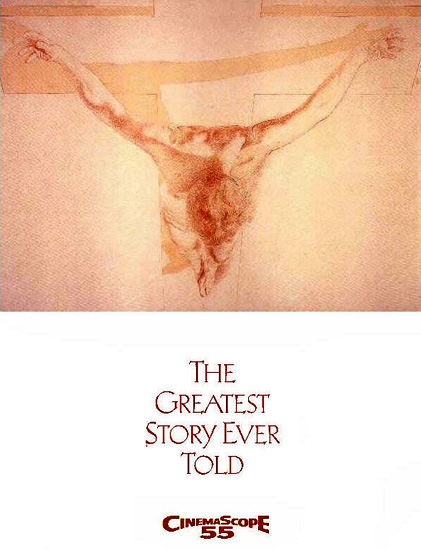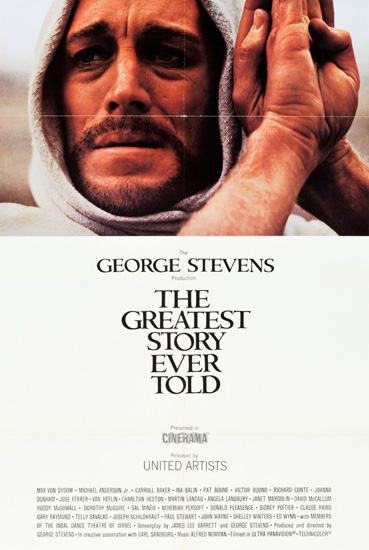The Greatest Story Ever Told: The 70mm Epic Hardly Anyone Has Seen |
Read more at in70mm.com The 70mm Newsletter |
| Written by: Ken Kunkel, Tampa, Florida | Date: 19.01.2018 |
 In
your local electronic store, on Netflix, or on your favorite web store, you
will find "The Greatest Story Ever Told" on DVD or Blu-ray. But then again,
it's not really there. In
your local electronic store, on Netflix, or on your favorite web store, you
will find "The Greatest Story Ever Told" on DVD or Blu-ray. But then again,
it's not really there. In February of 1965, George Stevens would at long last premiere his labor of love that he had worked on for so many years. Whenever a new photographic process came out, he would adopt it for his project. Early ads appeared announcing it would be in Cinemascope 55. Initial filming even started with three camera Cinerama but quickly switched over to the Ultra Panavision version when it appeared. The production was fraught with problems: nasty power plays, weather, and Stevens' lengthy production schedule, to mention a few. Other directors were brought in uncredited to film scenes to finally bring it to completion. But here it was, the world premiere of the 3 hour 45 minute (plus intermission) epic was finally going to be unveiled at the New York Warner Cinerama Theater. (A 4 hour and 20 minute version seems to only be a rumour.) Reviews were mixed at best. Criticism centered around the slow pace, the uninflected tone, some clunky dialogue and the number of cameo appearances by famous actors and actresses (which I think was unfair). Its strengths were recognized too: Max von Sydow's serene portrayal of Christ, the beautiful Oscar-nominated cinematography (which is still studied by cinematographers today), and the performances of many of the supporting cast. Still, it seemed like everyone was scratching their heads about George Stevens' intentions. But actually, they were displayed in plain sight: one by the use of Cinerama and the other by the souvenir program itself. Cinerama is usually used with action-oriented stories and obviously the life of Christ does not fit that mold. Cinerama was designed to "put you in the picture" and there we have it. In the souvenir program, instead of presenting cast and crew bios along with production notes, there was his statement of intention: to let the audience gain a sense of what it was like to be there when He walked the earth. So how do you accomplish this? Move slowly and be drawn in. A very risky approach which requires delicate timing achieved through extremely careful editing. I was very fortunate to have seen the original version within the first month of its original roadshow engagement in Pittsburgh's Warner Theater. Back then, it was almost a tradition to start trimming these long films right after they came out. They usually gave the excuse that they could show it more often, which usually never happened. It seemed like they were simply trying to attract more people by making them shorter. "Lawrence of Arabia," "Cleopatra" and others suffered the same fate. It was announced that after the first month, "The Greatest Story Ever Told" would be cut. The new 3 hour and 17 minute version then appeared in the theaters and that is the version you will find today. In the early 70's, I drove my new wife from the North Hills of Pittsburgh to the South Hills to see a special re-release of the film. I had talked incessantly about how she would enjoy it. After the film as we walked back to the car, she reviewed the film with a solid "Huh?" and I spent the walk cursing. The cutters obviously did not understand what Stevens was doing. |
More in 70mm reading: Motion pictures photographed in MGM Camera 65 / Ultra Panavision 70 Ultra Panavision 70 - almost like a real story The Widest Story Ever Told Internet link: |
 It seemed like almost every scene was trimmed, which resulted in breaking
Stevens' delicate rhythm. It now had this jerky feeling. But something even
worse had been done: the two major scenes which delivered the film's
emotional punch were eviscerated. I can hear you ask: What emotional punch?
There is no emotional punch in this movie. Yes, the original "Greatest Story
Ever Told" does have one. It seemed like almost every scene was trimmed, which resulted in breaking
Stevens' delicate rhythm. It now had this jerky feeling. But something even
worse had been done: the two major scenes which delivered the film's
emotional punch were eviscerated. I can hear you ask: What emotional punch?
There is no emotional punch in this movie. Yes, the original "Greatest Story
Ever Told" does have one.The first major sequence is the lead-in to intermission: the raising of Lazarus. So far in the film, the divinity of Christ is rather debatable. This sequence would prove it. Much of the sequence has the huge Cinerama screen filled with the dramatic cliff face, with Christ and the tomb entrance sitting on the bottom of the screen, emphasizing nature over the characters. This would be switched with reactions of the various onlookers. The rock in front of the tomb is slowly rolled away. A close up of Christ's face has him quietly calling together the four winds. The slowness of the scene had my mind starting to scream with this contrast of overwhelming nature and Christ's audacity to reverse nature's laws. It actually made the sequence rather frightening. Then, when Christ shouts those famous three words, nothing happens. More onlooker reactions. The tomb entrance remains dark. Then, very slowly, something vaguely moves in the tomb's darkness. Lazarus inches forward as Alfred Newman's strings begin to rise. This is an incredible emotional moment with the onlookers registering their disbelief. In the current version, the whole sequence is shortened with much of the onlookers' reactions removed and Lazarus just magically appearing at the tomb entrance. If cuts were to be made, perhaps the silliness of running to the city gates after the event could have been lost. Instead, show them running away from the camera to the city. And it could have ended with that incredible tableau of Jesus standing beside the tomb with Lazarus standing at its entrance. It would have been more than sufficient. The second sequence is the Crucifixion. Now, there are some basic faults with this sequence, the biggest of which is the fact that it was filmed in a studio. It was stated that the film would experiment with the removal of color and maybe this sequence was meant to be one of them, but the money ran out. But, all of this was made up for by the portion that was removed. Christ dies slowly, looking directly at the audience, breaking the fourth wall. His eyes slowly close, then open, close again, open again, close, open. I remember hearing people openly weeping in the theatre. Finally, incredibly weak, he announces that it is finished, his eyes close a final time and his head drops onto his chest. This was the most emotionally powerful crucifixion ever filmed. The edited version simply has him stating the end and dropping his head to his chest. Obviously, the editors did not know what they were doing. The guts of the sequence were crudely removed. In summary, "The Greatest Story Ever Told" version that is found today is abridged and not the original. Only the people who saw the film in its first month of release experienced a powerful, emotional experience. But, it is rumored that in the bowels of the U.S. Library of Congress, there sits an intact version of the original. Does the MGM/UA vaults contain the original negative? Hopefully, someday, it will see the light of day and be projected where it belongs, on a large Cinerama screen at one of the world's 70mm festivals. Then, everyone will also be able to experience the incredible emotion that was generated by George Stevens' unique vision of the life of Christ. |
|
| Go: back - top - back issues - news index Updated 22-01-25 |
